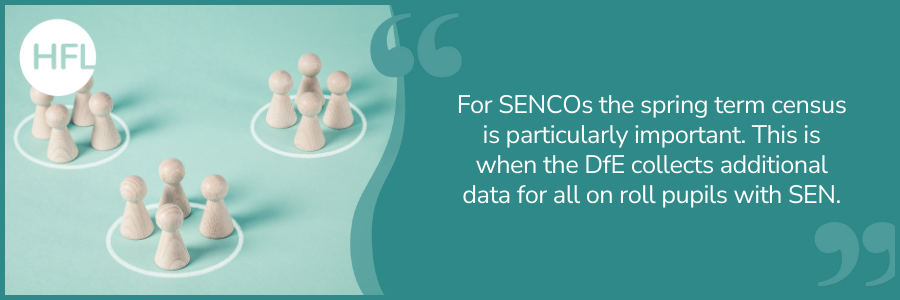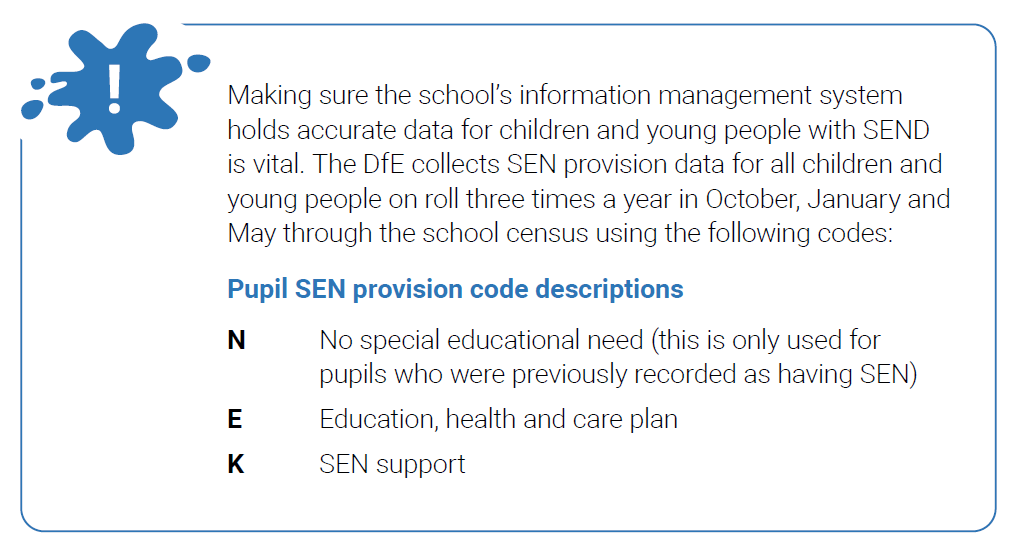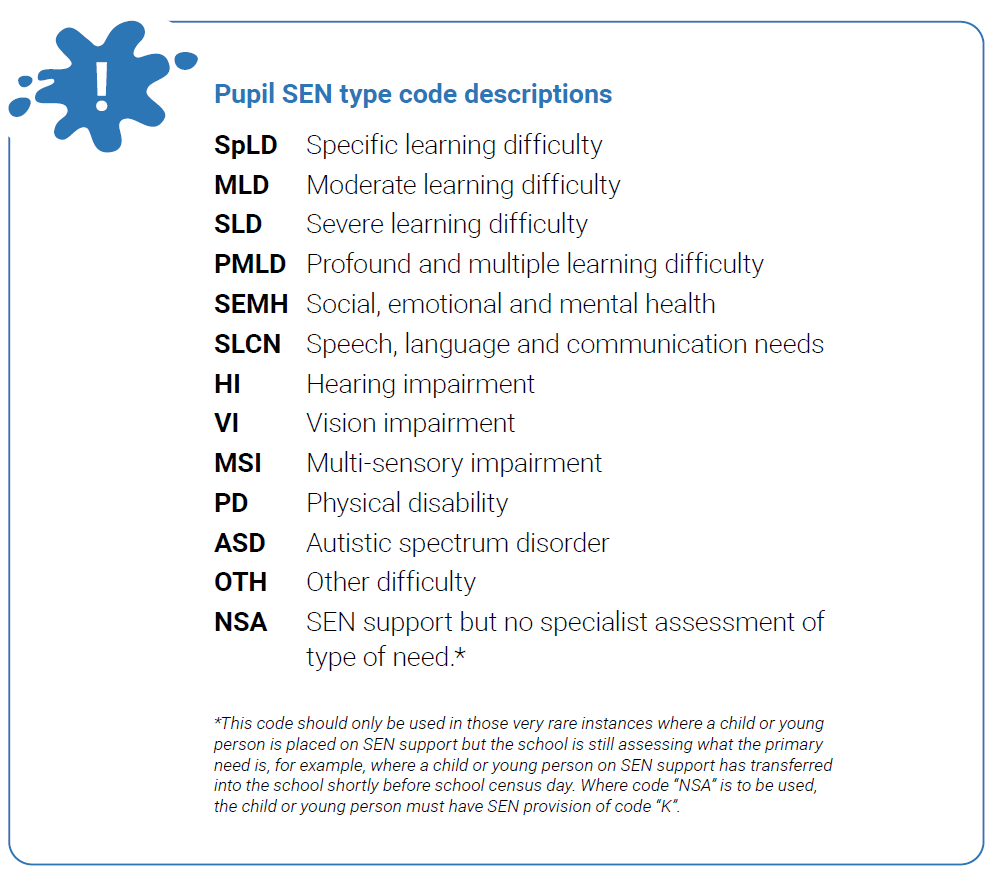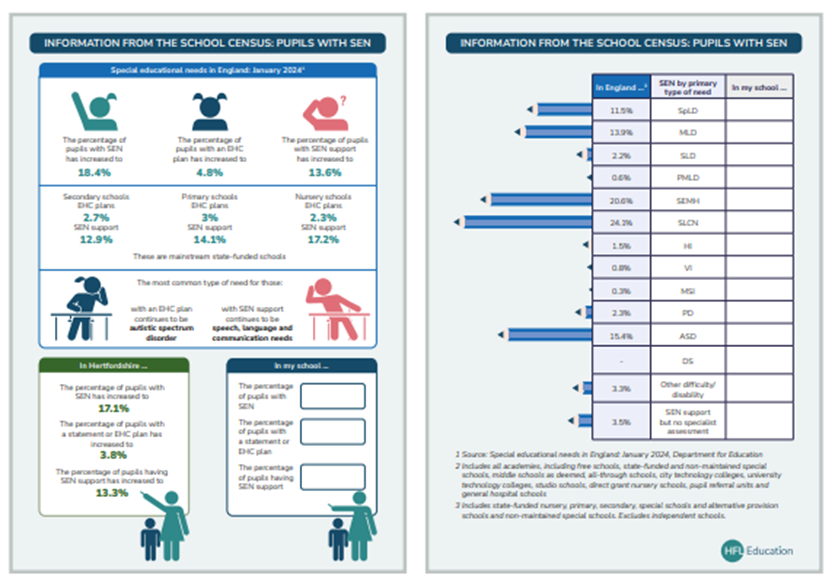
*This blog was oringinally published on 03/01/2024
You may have heard of the Department for Education’s (DfE) School Census but may not know much about it - it collects information from primary schools, secondary schools, special schools, maintained nurseries and academies and pupil referral units three times a year. SEN provision is collected for all pupils on roll every census day using the following codes: ‘E’ (Education, Health and Care plan) or ‘K’ (SEN support).
However, for SENCOs the spring term census is particularly important. This is when the DfE collects additional data for all on roll pupils with SEN. This year the census will be completed on Thursday 16th January 2025.
This blog will give you a few top tips to make sure you are well-prepared, answer some frequently asked questions and explain what happens with the information after it has been submitted to the DfE.
What do SENCOs need to do to prepare for the census?
Before January 16th have a conversation with whoever completes the School Census in your school (usually the office manager or school business manager) to ensure that the information held about the pupils with SEN in your management information system (MIS) is accurate.
Check:
- Is the list of pupils identified with SEN on your MIS correct?
- Do all pupils with SEN have an accurate SEN provision code description?
If you would like some more information about when to identify a child with SEN, then please refer to the SEND Code of Practice (paragraph 6.15). You may also find this recent article by Sara Alston useful: Who should go on the school SEN register?

Is the SEN type code description correct?
To be recorded under one of the SEN types, there is no requirement for a pupil to have a specialist assessment, though it is important, as part of your ongoing conversations with families, that they are aware of the SEN type code descriptions the school is using.
For the School Census, you must choose a SEN type code description from the list provided. This is available in Hertfordshire’s SEND Toolkit. For 2024-25 the DfE has introduced an update to the Pupil SEN type codes to include Down Syndrome.
You will find more information about some of the SEND type descriptions in the SEND Code of Practice paragraphs 6.30 to 6.34.

- Is every pupil’s primary need – and, where appropriate any secondary need – recorded as an SEN type ranking? Only two rankings are collected in the School Census - the most significant, or primary need, is ranked as ‘1’, with any secondary need ranked ‘2’.
If your school has an MIS support contract with HFL Education you will be able to find more information about how to record SEN on the Data Management Services Portal. If not, you will need to access any help guides provided by your school’s management information system (for example: Arbor, SIMS, BromCom or ScholarPack).
Does my school have an SEN Unit or Resourced provision?
These indicators identify pupils with SEN who are members of a SEN unit or a specialist-resourced provision.
- SEN units are special provisions within a mainstream school where the pupils with SEN are taught within separate classes for at least half of their time.
- Resourced provisions are places that are reserved at a mainstream school for pupils with a specific type of SEN, taught for at least half of their time within mainstream classes, but requiring a base and some specialist facilities around the school.
Schools and academies must only use these indicators where the SEN unit or resourced provision has been formally recognised as such by the local authority where the school is located. The school’s get information about schools (GIAS) record should indicate if the school has an SEN unit or a resourced provision.
What happens after the data has been submitted?
Submitting the correct data is important.
The data SENCOs submit is collated by the DfE who then use it to publish national SEN statistics in June every year. You may not realise it, but this is the data used to create the SEND Context poster published annually in Hertfordshire’s SEND Toolkit - a helpful tool enabling SENCOs, school leaders and governors to understand their own school context.

For example, we know from the 2024 national SEN statistics that 13.6% of children are identified as receiving SEN support, and 4.8% of children have an Education, Health and Care Plan (EHCP). We know that the most common type of need for those with SEN support continues to be speech, language and communication needs (SLCN).
The School Census information is also used in other databases, such as Ofsted’s inspection data summary report (IDSR) which is used by inspectors when preparing for and during inspection to access information about individual schools.
If you have made any changes to your data, you may want to update your SEND Context poster and share with your leadership team and governors.
Make sure that parents have been informed of any changes to those identified with SEN. Follow up conversations in writing, giving a copy to parents as well as retaining a copy for the school’s records.
Please subscribe if you would like to receive new blogs from the SEND team as they are published: Subscribe
Links to resources that you might find useful:
Complete the school census - Guidance - GOV.UK
SEND Code of Practice: 0 to 25 years
SEND toolkit sixth edition | HFL Education
Special educational needs in England, Academic year 2023/24 - Explore education statistics - GOV.UK
Sara Alston article: Who should go on the school SEN register?
Please do not hesitate to get in touch with a member of the SEND team if you would like to explore this issue further.



